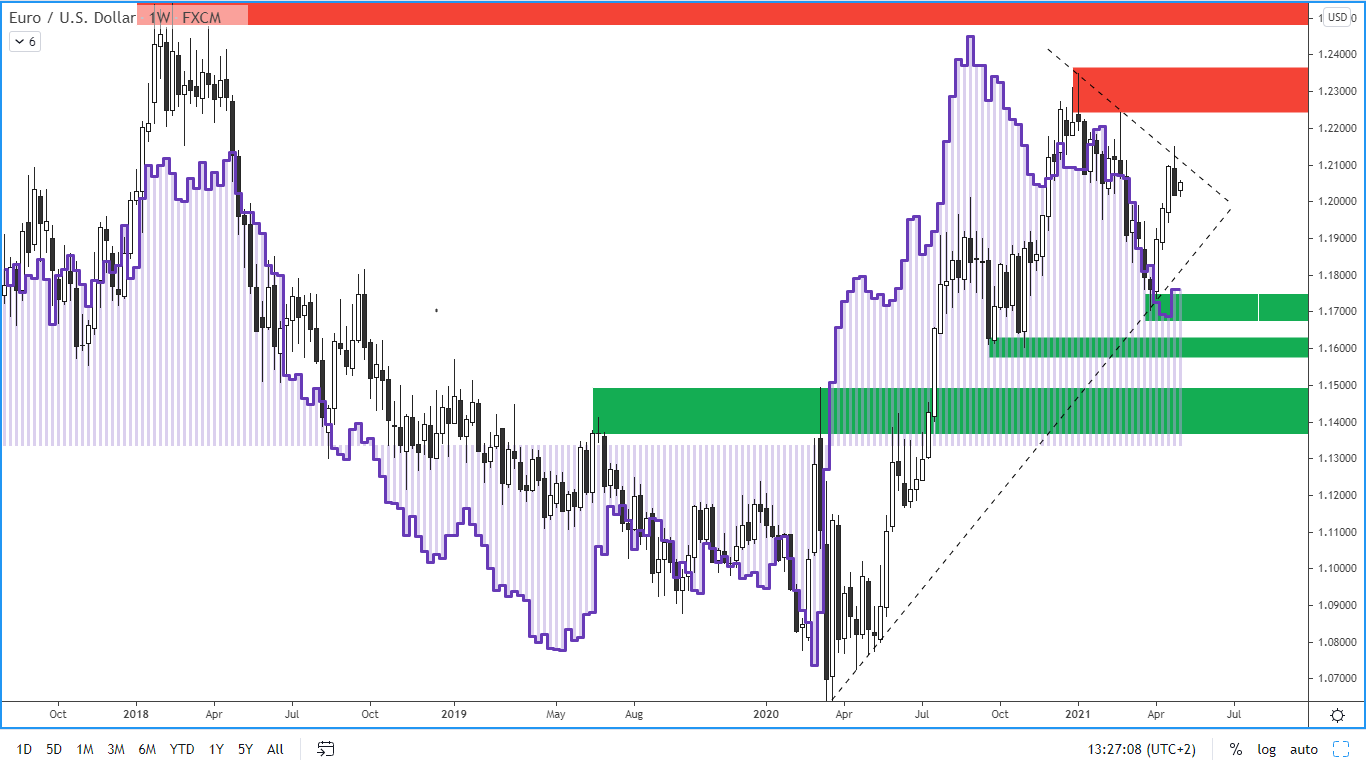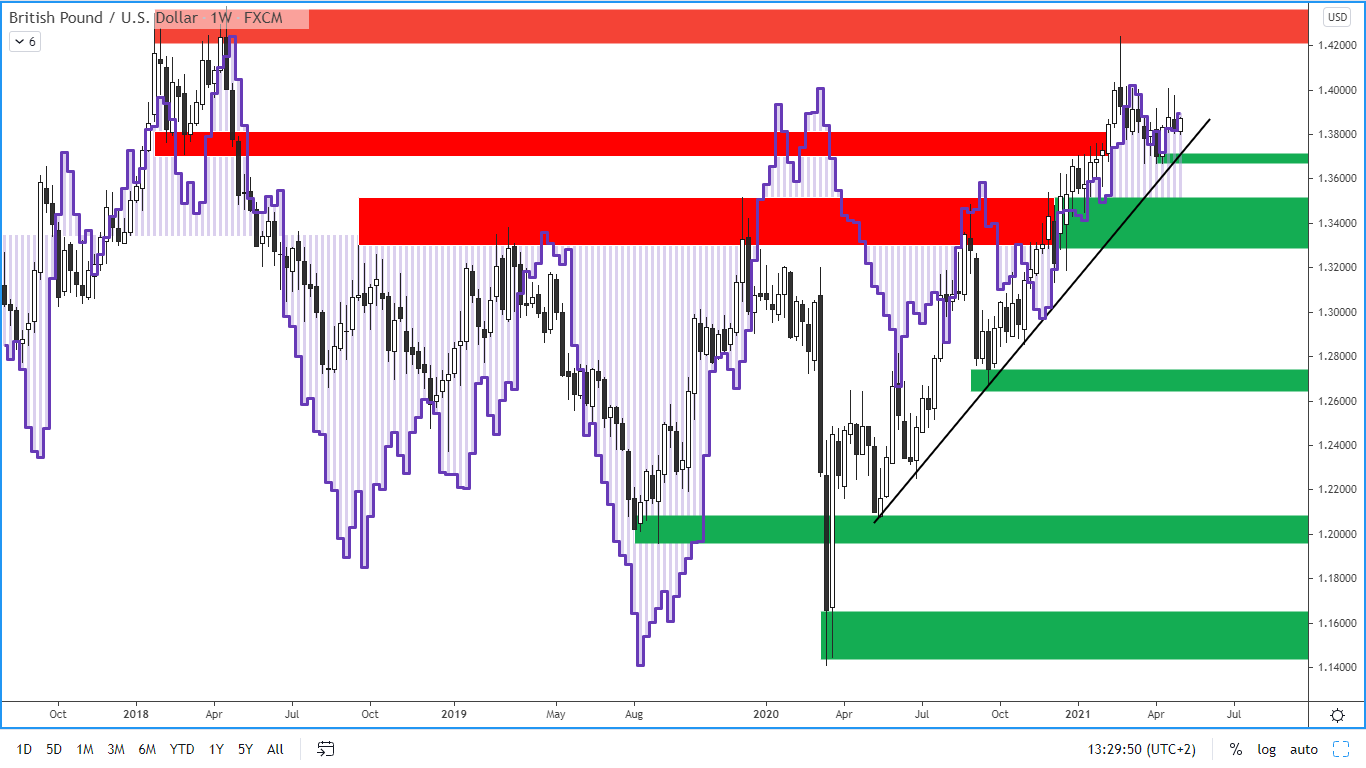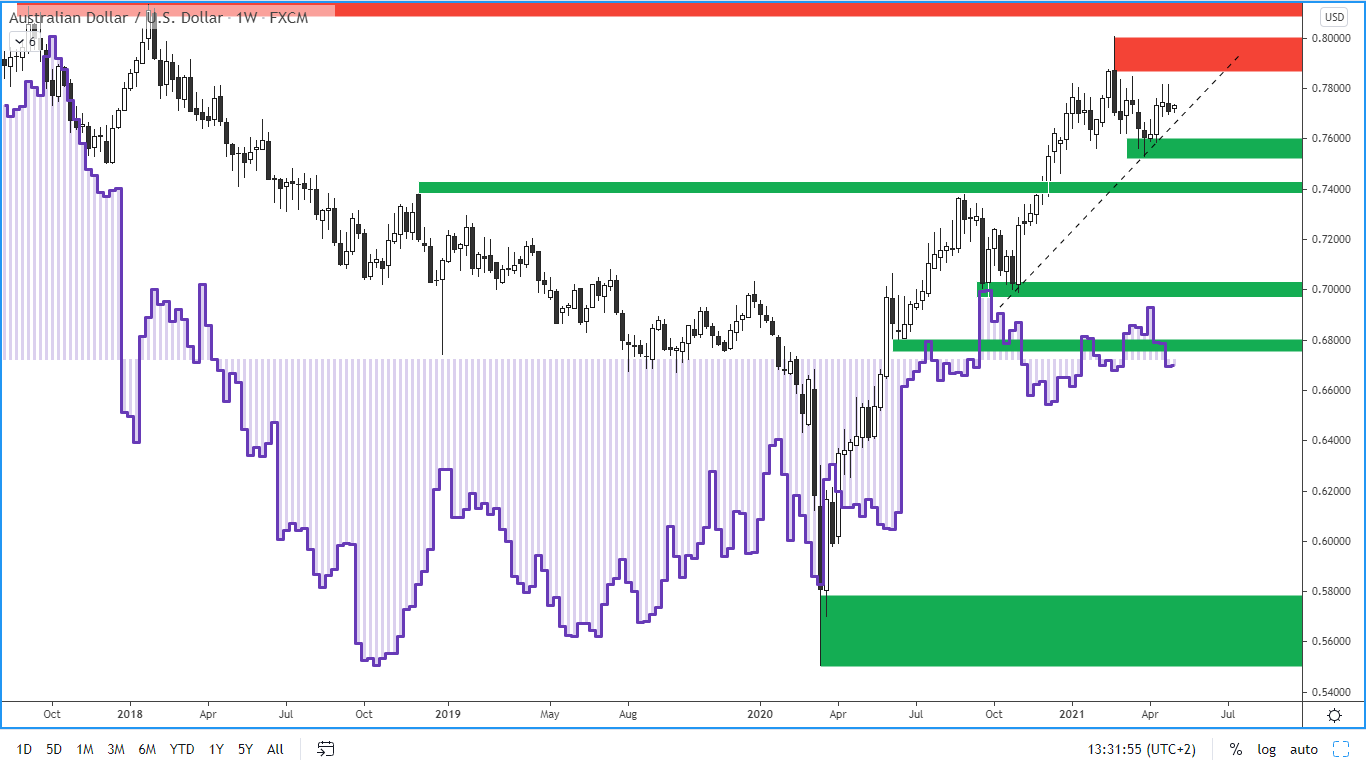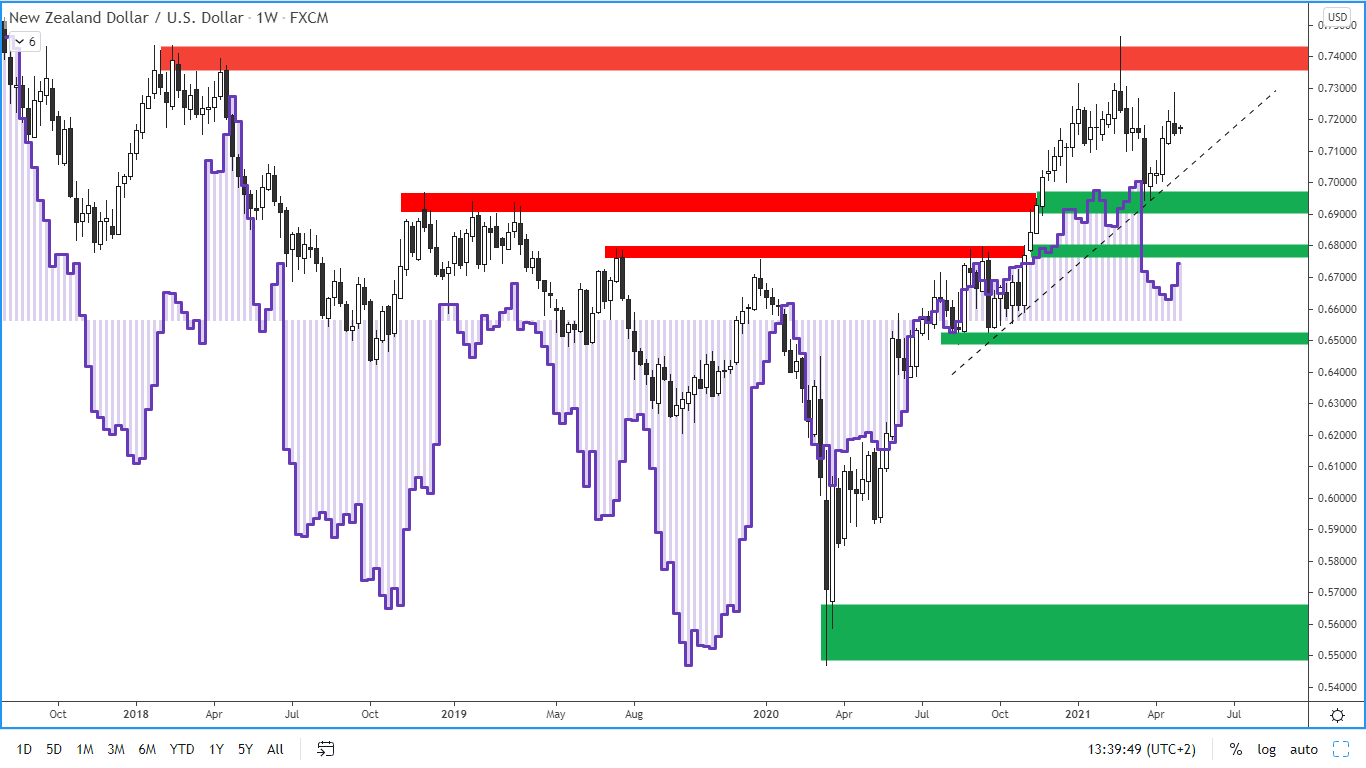Positions of large speculators according to the COT report as at 30/4/2021
The total net positions of speculators in the USD index fell to 800 contracts last week. This change is the result of a decrease in net long positions by 900 contracts and a decrease in net short positions by 100 contracts.
The total net positions of speculators increased last week in the euro, the British pound, the Australian dollar, the New Zealand dollar, the Canadian dollar, the Swiss franc and the Japanese yen. Canadian dollar and New Zealand dollar.
Developments on US dollar pairs have recently been determined by the development in US long-term bond yields. In case of their further stronger growth, the dollar might continue to strengthen.
The positions of speculators in individual currencies
The overall net positions of large speculators are shown in Table 1:
|
|
30/4/2021
|
23/4/2021
|
16/4/2021
|
9/4/2021
|
2/4/2021
|
26/3/2021
|
|
USD index
|
2,700
|
3,500
|
6,000
|
4,400
|
5,700
|
5,400
|
|
EUR
|
81,000
|
80,800
|
66,900
|
67,500
|
73,700
|
93,300
|
|
GBP
|
29,200
|
25,200
|
25,600
|
20,000
|
25,000
|
21,800
|
|
AUD
|
-1,400
|
-1,800
|
3,800
|
4,100
|
12,300
|
5,900
|
|
NZD
|
7,000
|
4,300
|
2,500
|
3,100
|
4,000
|
4,700
|
|
CAD
|
15,722
|
13,200
|
2,400
|
2,700
|
6,500
|
5,100
|
|
CHF
|
-700
|
-1,600
|
800
|
3,200
|
4,300
|
2,900
|
|
JPY
|
-48,500
|
-59,800
|
-58,300
|
-58,000
|
-59,500
|
-53,500
|
Table 1: Total net positions of large speculators
Notes:
Large speculators are traders who trade large volumes of futures contracts, which, if the required limits are met, must be reported to the Commodity Futures Trading Commission. Typically, this includes traders such as funds or large banks. These traders mostly focus on trading of long-term trends.
Total net positions are the difference between the number of bullish long contracts and the number of bearish short contracts. The data is published every Friday and is delayed because it shows the status on Tuesday of the week.
The sentiment of large speculators will allow you to see what position this group occupies in the market. It is important to monitor the overall trend of total net positions, but also separately the trend of bearish short positions and the trend of bullish long positions. Extreme values of total net positions are also important as they often serve as signals of a trend reversal.
It is also important to monitor the turning points, when the total net positions change from bullish sentiment to bearish and vice versa. These inflection points are indicated in the graphs in section 3.
The chart compares the current value of the total net positions of large speculators with the value 3 years ago. A score of 0% means that speculators are at their lowest levels in 3 years. A score of 100% means that speculators are at the highest values in the last 3 years. A value of 80% or more means that speculators are extremely bullish, and a value of 20% or less means that speculators are extremely bearish.
Detailed analysis of selected currencies
Explanations:
-
Purple line and histogram in the chart window: this is information on the overall net position of large speculators.
-
Green linein the indicator window: these are the bullish positions of large speculators.
-
Red line in the indicator window: indicates the bearish positions of large speculators.
If there is a green line above the red line in the indicator window, then it means that the overall net positions are positive, i.e. that bullish sentiment prevails. If, on the other hand, the green line is below the red line, then bearish sentiment prevails and the overall net positions of the big speculators are negative.
Charts are made with the use of www.tradingview.com.
The Euro
|
Date
|
Weekly change in open interest
|
Weekly change in total net positions of speculators
|
Weekly change in total long positions of speculators
|
Weekly change in total short positions of speculators
|
Sentiment
|
| 30/4/2021 |
10,400 |
200 |
3,300 |
3,100 |
Bullish |
| 23/4/2021 |
13,000 |
13,900 |
6,500 |
-7,400 |
Bullish |
| 16/4/2021 |
6,000 |
-600 |
-1,500 |
-900 |
Weakening bullish |
 Figure 1: The euro and COT positions of large speculators on a weekly chart
Figure 1: The euro and COT positions of large speculators on a weekly chart
The total net positions of speculators grew by 200 contracts last week. This change is due to an increase in net long positions by 3,300 contracts and an increase in net short positions by 3,100 contracts.
The price of the euro weakened slightly last week as it rebounded from the upper declining line, which now acts as a resistance. After breaking it and testing it back as a new support, one might expect the euro to strengthen against the dollar.
Long-term resistance: 1.1980 - 1.2020
Long-term support: 1.1700 - 1.1750
The British Pound
|
Date
|
Weekly change in open interest
|
Weekly change in total net positions of speculators
|
Weekly change in total long positions of speculators
|
Weekly change in total short positions of speculators
|
Sentiment
|
| 30/4/2021 |
-3,000 |
4,000 |
-1,100 |
-5,100 |
Bullish |
| 23.4.2021 |
15,500 |
-400 |
8,200 |
8,600 |
Weakening bullish |
| 16.4.2021 |
8,200 |
5,600 |
7,500 |
1,900 |
Bullish |
 Figure 2: The GBP and COT positions of large speculators on a weekly chart
Figure 2: The GBP and COT positions of large speculators on a weekly chart
Last week, the total net position of speculators fell by 4,000 contracts. This change is the result of a decrease in net long positions by 1,100 contracts, while net short positions decreased by 5,100 contracts
The pound weakened slightly against the US dollar last week.
Long-term resistance: 1.42-1.4350
Long-term support: 1.3670-1.3700
The Australlian Dollar
|
Date
|
Weekly change in open interest
|
Weekly change in total net positions of speculators
|
Weekly change in total long positions of speculators
|
Weekly change in total short positions of speculators
|
Sentiment
|
| 30.4.2021 |
4,600 |
400 |
3,000 |
2,600 |
Weakening bearish |
| 23.4.2021 |
-3,500 |
-5,600 |
-7,300 |
-1,700 |
Bearish |
| 16.4.2021 |
2,400 |
-300 |
1,000 |
1,300 |
Weakening bullish |
 Figure 3: The AUD and COT positions of large speculators on a weekly chart
Figure 3: The AUD and COT positions of large speculators on a weekly chart
Last week, the total net positions of speculators grew by 400 contracts. This change is due to an increase in long positions by 3,000 and an increase in short positions by 2,600 contracts.
The Australian dollar weakened slightly last week, but overall it is still in a rising trend in line with risk on sentiment.
Long-term resistance: 0.7870-0.8000
Long-term support: 0.7530-0.7600
The New Zealand dollar
|
Date
|
Weekly change in open interest
|
Weekly change in total net positions of speculators
|
Weekly change in total long positions of speculators
|
Weekly change in total short positions of speculators
|
Sentiment
|
| 30/4/2021 |
3,500 |
2,700 |
4,200 |
1,500 |
Bullish |
| 23/4/2021 |
2,200 |
1,800 |
2,000 |
200 |
Bullish |
| 16/4/2021 |
1,100 |
- 600 |
500 |
1,100 |
Weakening bullish |
 Figure 4: The NZD and the position of large speculators on a weekly chart
Figure 4: The NZD and the position of large speculators on a weekly chart
Last week, total net positions grew by 2,700 contracts. This change is the result of an increase in net long contracts by 4200 and an increase in net short contracts by 1500.
The NZDUSD weakened last week and formed a bearish pinbar. However, as stock indices continue to strengthen, a further strenghtening in this pair might occur as well as this pair strongly correlates with the SP500 index. However, if US bond rates rose sharply, the US dollar would rather be expected to strengthen and the NZDUSD could weaken. The movement of the NZDUSD pair is also strongly correlated with the AUDUSD.
Resistance: 0.7370-0.7450
The nearest support: 0.6900-0.6960